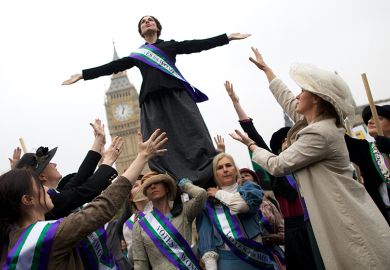Natalie Davis has a special talent for spotting good stories. In her last book, Fiction in the Archives, she unearthed the vivid tales told by ordinary 16th-century French folk - convicted of capital offences - as they tried to obtain a royal pardon: the husband who claimed to have murdered his unfaithful wife, caught in the act, in "hot anger"; the wife describing how her husband had come at her in a drunken rage as she prepared a chicken for cooking, and had accidentally "met her knife".
In the book that made her scholarly reputation, The Return of Martin Guerre, Davis explored the evasions and omissions in the story of Bertrande de Rols, deserted wife of Martin Guerre, who failed to detect the fact that the man who returned more than eight years later, and who fathered two children, was an impostor. How could Bertrande not have known that the gentle, loving Arnaud du Tilh was a different person from the inadequate, abusive husband who had abandoned her?
In her new book, Women on the Margins: Three 17th-Century Lives, the series of tales Davis tells concerns the lives of three exceptional yet virtually forgotten women, each of which was lived under curious and difficult circumstances, and each of whom left autobiographical written (and in one case, painted) testimony to her personal struggle to give shape and coherence to what she was experiencing.
The task Natalie Davis sets herself as a historian is to extract from such evidence some understanding of an early modern sense of self. She negotiates a relationship across time with each woman, in an attempt to understand what made her life meaningful, both in her terms and ours - distinctive, yet exemplary. From her stories - "aberrant" or "uncharacteristic" stories in conventional historical terms - she weaves a novel form of historical account, a unique kind of contribution to our understanding of the past.
For the historian, the cast of characters in Women on the Margins is quirky, to say the least. Glikl bas Judah Leib, a 17th-century Jewish merchant woman living in Hamburg, who wrote the story (sprinkled with anecdotes and moral fables) of a life full of disappointment; Marie Guyart of Tours, who abandoned her 11-year-old son to become the Ursuline nun Marie de l'Incarnation, and who wrote an account of her harsh life among the Amerindians in Quebec; Maria Sibylla Merian from Frankfurt, who in 1699, in her fifties, travelled with her daughter to Suriname in the Dutch West Indies, where she executed a unique series of meticulously observed paintings of the flora and fauna which was published in Amsterdam as the Metamorphosis of the Insects of Suriname.
The narrative thread of each of these women's lives unfolds a sequence of acts of extraordinary personal courage, on the basis of decisions made largely without support and in the teeth of family or community disapproval - the decision to abandon husbands and children, to embark on hazardous long-distance journeys, to risk declaring heterodox arguments and unorthodox practices. These are the voices we have not usually heard from the past, voices which rumple the smooth, seamless fabric of more conventional social and intellectual historical accounts.
The paradox with which Davis presents the reader is that at bottom her three chosen women have only one thing in common - a wayward maverick individuality forced upon them as women of spirit born in an age which could not grant them intellectual space. Yet she claims them as offering together an alternative historical paradigm. It is this paradox which she dramatises in her introduction, in which in her own persona she argues back as the three women themselves speak up, refusing to be grouped together, and insisting on their unlikeness to one another. "It sound to me, historian Davis, as though you're the one who wanted adventures," observes Maria Sibylla Merian severely, having heard Davis's case. "Give me another chance," pleads Davis, "read it again."
Davis herself repeatedly stresses the uniqueness of each of the three women whose tales she tells, yet she also intimates that there are lessons to be learned from their similarities. Is there an overarching coherence in these stories? In the end, might it simply be the inspiring lessons from the past which late-20th-century women can learn from individual early modern women's obstinate adherence to personal conviction, commitment, determination - even rashness - which generates our excitement?
It would be a mistake, however, to imagine that Davis tells her tales naively, or that her work is methodologically innocent. What she is interested in is the "multiple dialogues" which carry the past down to us. Her strategy is that of the ethnographer: paying close attention to the particularities of those whose lives are patterned in ways fundamentally different from our own; systematically positioning such fragments of testimony so that they confirm the contours of a community and its practices which we can begin to recognise and comprehend. Her protagonists' self-discovery is woven out of the stories others have told, books they have read, snippets of other people's information.
Inwardness is revealed as a process of interaction between the individual and the shaping discourses around her. Uniqueness is tethered and made historically specific by this process. The task for a historian like Davis is to show us this process in action (and to do so in a manner which compels us to give it our attention).
Those who disdain Davis's approach maintain that she licenses idiosyncracy, preferring the eccentric loner to the representative figure from the past. Maria Sybilla Merian's observations of the way different species of insect share a habitat (recorded in her paintings) may have permitted an understanding of life-cycle and diet to which her scientific contemporaries were blinded by dominant taxonomical theories. But she herself did not make the connections - theory, indeed, was not part of her scientific outlook. What, then, is the scientific status of her interventions? Where does that leave her in the history of science?
The answer, I think, is that like her great predecessor Frances Yates, Davis's work crucially disturbs the confidently whiggish accounts we construct of the past so as to produce orderliness out of the multiple processes which gave rise to us.
She directs us to the deviant (indeed, marginal) activities and modes of thought which disrupted, and thereby helped shape the more complacent versions of our social and intellectual developments. There never was a time, she shows us, when the "mainstream" could be isolated from observation and thinking which responded to alien cultures (Marie de l'Incarnation's Amerindians), nor from styles of engagement with the real which hybridised disparate cultural traditions (Glikl bas Judah Leib's moral argument, interwoven with both German and Yiddish fable and fancy). And where the shafts of light she directs fall, we find the opportunities to reconsider and reshape our own social and intellectual history.
Lisa Jardine is professor of English and dean of arts, Queen Mary and Westfield College, University of London.
Women on the Margins: Three 17th-Century Lives
Author - Natalie Zemon Davis
ISBN - 0 674 95520 X
Publisher - Harvard University Press
Price - £15.95
Pages - 360
Register to continue
Why register?
- Registration is free and only takes a moment
- Once registered, you can read 3 articles a month
- Sign up for our newsletter
Subscribe
Or subscribe for unlimited access to:
- Unlimited access to news, views, insights & reviews
- Digital editions
- Digital access to THE’s university and college rankings analysis
Already registered or a current subscriber?



